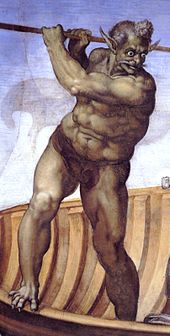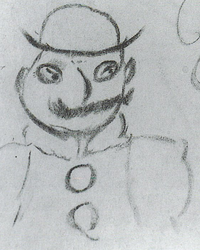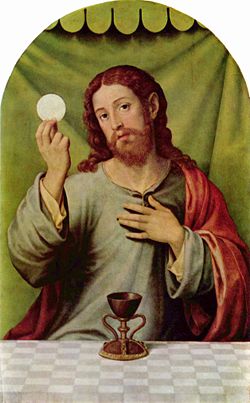Convent
A convent is either a community of priests, religious brothers or religious sisters (nuns); or the building used by the community, particularly in the Roman Catholic Church and in the Anglican Communion.
Flight attendant
Flight attendants or cabin crew (also known as stewards/stewardesses, air hosts/hostesses, cabin attendants) are members of an aircrew employed by airlines primarily to ensure the safety and comfort of passengers aboard commercial flights, on select business jet aircraft, and on some military aircraft.
Charon
In Greek mythology, Charon or Kharon (/ˈkɛərɒn/ or /ˈkɛərən/; Greek Χάρων) is the ferryman of Hades who carries souls of the newly deceased across the rivers Styx and Acheron that divided the world of the living from the world of the dead. A coin to pay Charon for passage, usually an obolus or danake, was sometimes placed in or on the mouth of a dead person. Some authors say that those who could not pay the fee, or those whose bodies were left unburied, had to wander the shores for one hundred years. In the catabasis mytheme, heroes – such as Aeneas, Dionysus, Heracles, Hermes, Odysseus, Orpheus, Pirithous, Psyche, Theseus and Sisyphus – journey to the underworld and return, still alive, conveyed by the boat of Charon.

Pyre
A pyre (Ancient Greek: πυρά; pyrá, from πῦρ, pyr, "fire"), also known as a funeral pyre, is a structure, usually made of wood, for burning a body as part of a funeral rite or execution. As a form of cremation, a body is placed upon or under the pyre, which is then set on fire.
Cremation
Cremation is the combustion, vaporization and oxidation of cadavers to basic chemical compounds, such as gases, ashes and mineral fragments retaining the appearance of dry bone. Cremation may serve as a funeral or post-funeral rite as an alternative to the interment of an intact dead body in a coffin, casket or shroud. Cremated remains (aka "cremains" or simply, "ashes"), which do not constitute a health risk, may be buried or interred in memorial sites or cemeteries, or they may be retained by relatives and dispersed in various ways. Cremation is not an alternative to a funeral, but rather an alternative to burial or other forms of disposal. Some families prefer to have the deceased present at the funeral with cremation to follow; others prefer that the cremation occur prior to the funeral or memorial service.
Odysseus
Odysseus also known by the Latin variant Ulysses , was a legendary Greek king of Ithaca and the hero of Homer's epic poem the Odyssey. Odysseus also plays a key role in Homer's Iliad and other works in that same epic cycle.
Husband of Penelope, father of Telemachus, and son of Laërtes and Anticlea, Odysseus is renowned for his intellectual brilliance, guile, and versatility (polytropos), and is hence known by the epithet Odysseus the Cunning (mētis, or "cunning intelligence"). He is most famous for his nostos or “homecoming”, which took him ten eventful years after the decade-long Trojan War.
Ulysses
Ulysses is a modernist novel by Irish writer James Joyce. It was first serialised in parts in the American journal The Little Review from March 1918 to December 1920, and then published in its entirety in Paris by Sylvia Beach on 2 February 1922, Joyce's 40th birthday. It is considered to be one of the most important works of modernist literature, and has been called "a demonstration and summation of the entire movement". According to Declan Kiberd, "Before Joyce, no writer of fiction had so foregrounded the process of thinking."
James Joice
James Augustine Aloysius Joyce (2 February 1882 – 13 January 1941) was an Irish novelist, short story writer, and poet. He contributed to the modernist avant-garde and is regarded as one of the most influential and important authors of the 20th century.
Joyce is best known for Ulysses (1922), a landmark work in which the episodes of Homer's Odyssey are paralleled in a variety of literary styles, perhaps most prominently stream of consciousness. Other well-known works are the short-story collection Dubliners (1914), and the novels A Portrait of the Artist as a Young Man (1916) and Finnegans Wake (1939). His other writings include three books of poetry, a play, occasional journalism and his published letters.

Leopold Bloom
Leopold Bloom is the fictional protagonist and hero of James Joyce's Ulysses. His peregrinations and encounters in Dublin on 16 June 1904 mirror, on a more mundane and intimate scale, those of Ulysses/Odysseus in Homer's epic poem the Odyssey. The character was inspired by James Joyce's close friend Aron Ettore Schmitz (Italo Svevo), author of Zeno's Conscience.
Stephen Dedalus
Stephen Dedalus is James Joyce's literary alter ego, appearing as the protagonist and antiheroof his first, semi-autobiographical novel of artistic existence A Portrait of the Artist as a Young Man and an important character in Joyce's Ulysses.
In Stephen Hero, an early version of what became Portrait, Stephen's surname is spelled "Daedalus" in more precise allusion to Daedalus, the architect in Greek myth who was contracted by King Minos to build the Labyrinth in which he would imprison his wife's son the Minotaur. Buck Mulligan makes reference to the mythological namesake in Ulysses, telling Stephen, "Your absurd name, an ancient Greek!" In revising the mammoth Stephen Hero into the considerably more compact Portrait of the Artist as a Young Man, Joyce shortened the name to "Dedalus".
Orpheus
Orpheus (/ˈɔːrfiəs, ˈɔːrfjuːs/; Greek: Ὀρφεύς) was a legendary musician, poet, and prophet in ancient Greek religion and myth. The major stories about him are centered on his ability to charm all living things and even stones with his music, his attempt to retrieve his wife, Eurydice, from the underworld, and his death at the hands of those who could not hear his divine music. As an archetype of the inspired singer, Orpheus is one of the most significant figures in the reception of classical mythology in Western culture, portrayed or alluded to in countless forms of art and popular culture including poetry, film, opera, music, and painting.


Dubliners
Dubliners is a collection of fifteen short stories by James Joyce, first published in 1914. They form a naturalistic depiction of Irishmiddle class life in and around Dublin in the early years of the 20th century.
The stories were written when Irish nationalism was at its peak, and a search for a national identity and purpose was raging; at a crossroads of history and culture, Ireland was jolted by various converging ideas and influences. They centre on Joyce's idea of an epiphany: a moment where a character experiences a life-changing self-understanding or illumination. Many of the characters in Dubliners later appear in minor roles in Joyce's novel Ulysses. The initial stories in the collection are narrated by child protagonists, and as the stories continue, they deal with the lives and concerns of progressively older people. This is in line with Joyce's tripartite division of the collection into childhood, adolescence and maturity.

Holy Chalice
The Holy Chalice is the vessel which in Christian tradition Jesus used at the Last Supper to serve the wine. The vessel is referred to in the synoptic gospels as ποτήριον ("cup, drinking vessel"). The celebration of the Eucharist in Christian churches and communities retains the original elements of the Last Supper, the bread and the cup or chalice, with the celebrant using the words of Jesus, as recorded in the Gospels. The Holy Chalice in the form of the Holy Grail became a topos in Arthurian romance in the high medieval period. In Roman Catholic relic veneration of the later medieval period, two artifacts, one kept in Genoa and the other in Valencia, were identified as the Holy Chalice.
Relic
In religion, a relic usually consists of the physical remains of a saint or the personal effects of the saint or venerated person preserved for purposes of veneration as a tangible memorial. Relics are an important aspect of some forms of Buddhism, Christianity, Islam, Hinduism, Shamanism, and many other religions. Relic derives from the Latin reliquiae, meaning "remains", and a form of the Latin verb relinquere, to "leave behind, or abandon". A reliquary is a shrine that houses one or more religious relics.
Last Supper
The Last Supper is the final meal that, in the Gospel accounts, Jesus shared with his Apostles in Jerusalem before his crucifixion. The Last Supper is commemorated by Christians especially on Maundy Thursday. The Last Supper provides the scriptural basis for the Eucharist, also known as "Holy Communion" or "The Lord's Supper".
website: https://www.youtube.com/watch?v=997ni1xcmKw
Eucharist
The Eucharist /ˈjuːkərɪst/ (also called Holy Communion, the Lord's Supper, among other names) is a Christian rite that is considered a sacrament in most churches and an ordinance in others. According to the New Testament, the rite was instituted by Jesus Christ during his Last Supper; giving his disciples bread and wine during the Passover meal, Jesus commanded his followers to "do this in memory of me" while referring to the bread as "my body" and the wine as "my blood". Through the Eucharistic celebration Christians remember Christ's sacrifice of himself on the cross.
Poetry
Poetry (the term derives from a variant of the Greek term, poiesis, "making") is a form of literature that uses aesthetic and rhythmic qualities of language—such as phonaesthetics, sound symbolism, and metre—to evoke meanings in addition to, or in place of, the prosaic ostensible meaning.
Poetic form is more flexible in modernist and post-modernist poetry, and continues to be less structured than in previous literary eras. Many modern poets eschew recognisable structures or forms, and write in free verse. But poetry remains distinguished from prose by its form; some regard for basic formal structures of poetry will be found in even the best free verse, however much such structures may appear to have been ignored. Similarly, in the best poetry written in classic styles there will be departures from strict form for emphasis or effect.
Among major structural elements used in poetry are the line, the stanza or verse paragraph, and larger combinations of stanzas or lines such as cantos. Also sometimes used are broader visual presentations of words and calligraphy. These basic units of poetic form are often combined into larger structures, called poetic forms or poetic modes (see following section), as in the sonnet or haiku.
Sonnet
A sonnet is a poem in a specific form which originated in Italy; Giacomo da Lentini is credited with its invention.
The term sonnet is derived from the Italian word sonetto (from Old Provençal sonet a little poem, from son song, from Latin sonus a sound). By the thirteenth century it signified a poem of fourteen lines that follows a strict rhyme scheme and specific structure. Conventions associated with the sonnet have evolved over its history. Writers of sonnets are sometimes called "sonneteers", although the term can be used derisively.
In English, both the English or Shakespearean sonnet, and the Italian Petrarchan sonnet are traditionally written in iambic pentameter.
The first known sonnets in English, written by Sir Thomas Wyatt and Henry Howard, Earl of Surrey, used the Italian, Petrarchan form, as did sonnets by later English poets, including John Milton, Thomas Gray, William Wordsworth and Elizabeth Barrett Browning. Early twentieth-century American poet Edna St. Vincent Millay also wrote mostly Petrarchan sonnets.
On His Blindness by Milton, gives a sense of the Petrarchan rhyme scheme:
When I consider how my light is spent (a)
Ere half my days, in this dark world and wide, (b)
And that one talent which is death to hide, (b)
Lodged with me useless, though my soul more bent (a)
To serve therewith my Maker, and present (a)
My true account, lest he returning chide; (b)
"Doth God exact day-labour, light denied?" (b)
I fondly ask; but Patience to prevent (a)
That murmur, soon replies, "God doth not need (c)
Either man's work or his own gifts; who best (d)
Bear his mild yoke, they serve him best. His state (e)
Is Kingly. Thousands at his bidding speed (c)
And post o'er land and ocean without rest; (d)
They also serve who only stand and wait." (e)
Ere half my days, in this dark world and wide, (b)
And that one talent which is death to hide, (b)
Lodged with me useless, though my soul more bent (a)
To serve therewith my Maker, and present (a)
My true account, lest he returning chide; (b)
"Doth God exact day-labour, light denied?" (b)
I fondly ask; but Patience to prevent (a)
That murmur, soon replies, "God doth not need (c)
Either man's work or his own gifts; who best (d)
Bear his mild yoke, they serve him best. His state (e)
Is Kingly. Thousands at his bidding speed (c)
And post o'er land and ocean without rest; (d)
They also serve who only stand and wait." (e)
Sonnet 18
Sonnet 18, often alternatively titled Shall I compare thee to a summer's day?, is one of the best-known of 154 sonnets written by the English playwright and poet William Shakespeare. Part of the Fair Youth sequence (which comprises sonnets 1–126 in the accepted numbering stemming from the first edition in 1609), it is the first of the cycle after the opening sequence now described as the procreation sonnets.Shall I compare thee to a summer’s day?
Thou art more lovely and more temperate:
Rough winds do shake the darling buds of May,
And summer’s lease hath all too short a date:
Sometime too hot the eye of heaven shines,
And often is his gold complexion dimm’d;
And every fair from fair sometime declines,
By chance, or nature’s changing course, untrimm’d:
But thy eternal summer shall not fade,
Nor lose possession of that fair thou ow’st;
Nor shall Death brag thou wander’st in his shade,
When in eternal lines to time thou grow’st:
So long as men can breathe, or eyes can see,
So long lives this, and this gives life to thee.
沒有留言:
張貼留言